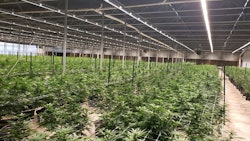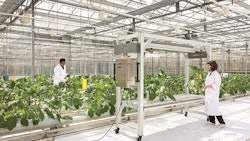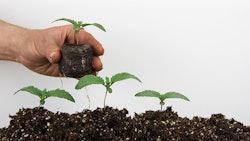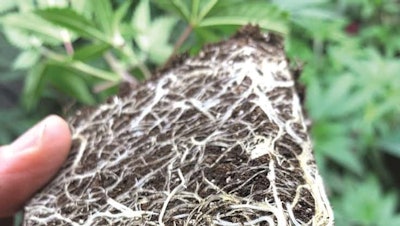
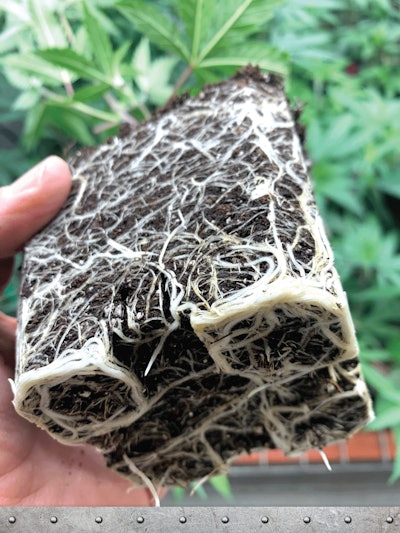
Bioaccumulation is defined as the accumulation of a substance, and particularly of a contaminant, over time in a living organism. When elements are absorbed by a living organism faster than they can be excreted or metabolized, they can continue to accumulate in tissue. When one organism consumes another, concentrations of chemicals or metals can multiply through the food chain in a process known as biomagnification. Seated at the top of the food chain, humans, in many cases, are at the greatest risk of consuming products contaminated with heavy metals. Regulations around heavy metal content in many products, including cannabis, are created to mitigate this risk. Due to the lack of federal oversight on cannabis, a majority of states have set varying limits for heavy metals in cannabis products, and the number of heavy metals tested for also varies by jurisdiction.
It is important to understand how to avoid heavy metal contamination in cannabis flower, particularly if you are growing in soil-type mediums, which can contain detectable levels.
Heavy Metals: What They Do
Plants use many metals as nutrient elements for growth, development and reproduction. Plants can make metal soluble using root secretions (exudates) to then absorb, or take up more directly, and soil microorganisms can play a significant role in absorption. In a 2016 paper published in Frontiers of Plant Science, researchers from the Centre for Plant Biotechnology and Genomics at the Polytechnic University of Madrid noted that:
Transition metals such as iron, copper, zinc, or molybdenum are essential nutrients for plants. These elements are involved in almost every biological process, including photosynthesis, tolerance to biotic and abiotic stress, or symbiotic nitrogen fixation [where plants trade carbon for nitrogen through a mutualistic relationship with bacteria]. However, plants often grow in soils with limited metallic oligonutrient [i.e. essential minor nutrient] bioavailability. Consequently, to ensure the proper metal levels, plants have developed a complex metal uptake and distribution system that not only involves the plant itself, but also its associated microorganisms. These microorganisms can simply increase metal solubility in soils and make them more accessible to the host plant, as well as induce the plant metal deficiency response, or directly deliver transition elements to cortical cells [outer soft tissue of leaves, stems and roots].
Nonessential, heavy metals can be assimilated through the same biological processes. Some species of plants exhibit a rapid health decline when nonessential metal uptake occurs, while others can show normal growth despite the toxic load they carry. Certain species of plants have roots that can tolerate high heavy metal content in soils and translocate metals more quickly from roots to shoots. These plants are referred to as hyperaccumulators, and they are often great candidates for use in phytoremediation—an earth-friendly and low-cost solution to cleaning up polluted soils and ecosystems. The metal-containing biomass can then be harvested and removed, leaving the soil undisturbed.
While this aggressive form of bioaccumulation can be a boon for the environment, it can be a big problem for hemp and cannabis producers.
Sources of Heavy Metals in Cannabis
Providing clean cannabis products for legal markets means, in most cases, passing heavy metal testing and, in many states, the thresholds for failure are quite low. Growers must be cautious to ensure that their plants will pass testing, thereby providing clean and safe products to their consumers. Possibly the most problematic heavy metal for cannabis cultivators is cadmium.
Cadmium, ranked the seventh most dangerous substance by the Agency for Toxic Substances and Disease Registry (ATSDR), is very water-soluble and has been a problem for other agricultural industries, including the tobacco industry. Cadmium pollution comes from atmospheric cadmium emissions, metal production, sewage sludge, fertilizers, disposal of cadmium-containing products like batteries and other sources, and is frequently found in soils.
A 2014 study published in Biotech assessed cannabis’ ability to pull cadmium from contaminated soils. The study states that cadmium is one of the most phytotoxic heavy metals, yet hemp plants were able to tolerate the toxicity in root tissue and efficiently translocate metals to aboveground biomass. While research is not available on cadmium concentration in cannabis leaves, studies have been done with tobacco plants.
Bioaccumulated cadmium in tobacco leaves can result in leaf tissue concentrations much higher than those in surrounding soils, a process known as bioconcentration. The problem gets worse when cadmium oxide is generated by the combustion process of smoking. Lung tissue has been shown to absorb more cadmium than the gastrointestinal tract, according to research published in a 2004 paper in Environmental Health Perspectives. As a result, cadmium concentration in tobacco smokers’ blood can be four to five times higher than nonsmokers, and studies have associated the risk of multiple lung diseases with exposure to cadmium-laced tobacco.
Arsenic is another heavy metal commonly found in various crops. Arsenic is a semi-metallic chemical element and a known carcinogen. Arsenic in soils can come from natural geological processes as well as agricultural and industrial ones, such as the mining and smelting of ores. Many pesticides commonly used in past decades contained elevated levels of arsenic, and soils have been degraded from exposure. In New Jersey alone, one 1998 study estimated that more than 83 million pounds of arsenate pesticides were applied to cropland, turf and golf courses between 1900 and 1980.
Phosphorus fertilizers, poultry and cow manures, and fish products are often contaminated with significant levels of heavy metals, and a study on glyphosate herbicides also uncovered many heavy metals present in those products, which are often sprayed on farm fields. One study analyzed 11 glyphosate-based herbicides, and found arsenic in nearly all samples at varying levels. In fact, all except three “had 5 to 53 times the permitted level of As (arsenic) in water in the European Union or USA,” according to a study published in Toxicology Reports.
Lead is another well-known environmental and health problem that has accumulated in soils from many sources of pollution, including vehicle exhaust, ammunition, plumbing, paints, smelting and fossil fuel emissions. Lead is the most prevalent heavy metal found in the environment, and high lead levels are often found in soils, fertilizers, compost and compost-based mediums, and in soil systems near air-polluting industries.
Mercury, also extremely toxic, bioaccumulates readily and has wreaked havoc on marine ecosystems. Mercury pollution comes from coal-fired power plants, wastewater, mining and agriculture, as well other industrial processes including pharmaceutical, paper pulp and caustic production. Fish and other marine fertilizers are used in cannabis production and can be contamination points for mercury, though, according to available research, cannabis appears much less likely to pull mercury from soils than cadmium, arsenic or lead.
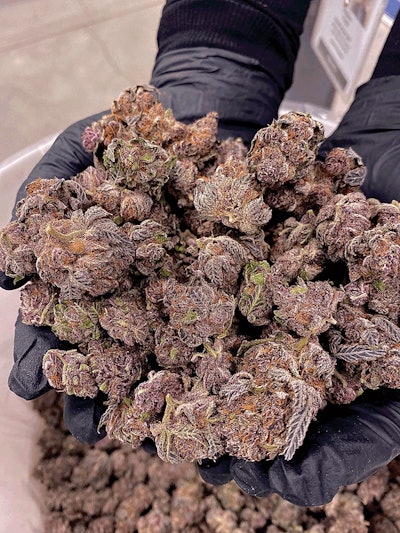
10 Tips To Protect Crops
Growing in field or potting soil comes with the risk of your crop pulling up heavy metals and translocating them to flower tissue. The challenges of cannabis production in soil, however, come with a potential reward as well. The bioaccumulation tendencies of cannabis mean that a myriad of elements are assimilated into tissue, and this can create a complex flavor profile, similar to the terroir effect in wine or the robust flavor enjoyed in soil-grown tomatoes.
Here are tips to procure nutrient-dense, flavor-packed flower while passing COAs:
1. Keep plants properly fed. If levels dip low, it may be easier for plants to pull up heavy metals. Studies show that heavy metals with similarities to nutrient cations, compete for absorption at root surface. For example, phosphorus is a chemical analogue of arsenic, and competes for uptake with it. The same holds true for zinc and cadmium.
2. Trust but verify state, supplier claims. Some states require fertilizers to pass heavy metal thresholds for use in agriculture within that state. Washington state has a user-friendly database that can be a helpful tool for monitoring heavy metals in many fertilizers commonly used in cannabis production. Manufacturers often provide heavy metal testing for fertilizers and soil amendments, as well. However, consider third-party testing of all inputs when vetting suppliers.
3. Pay close attention to any product used as a foliar spray, as this process may deposit metals directly on leaves, flower tissue or at bud sites. Guanos, manures and bone-derived products can all contain relatively high amounts of heavy metals due to biomagnification. Kelp and other seaweed-based fertilizers have been shown to have particularly high levels of heavy metals.
4. Test amendments. Amendments, particularly those made from concentrated plant material such as yucca extract or herbal products, can also contain surprising amounts of heavy metals. Have an independent lab test these products to avoid flower testing failures.
5. Avoid overapplication. Use leaf-tissue nutrient testing to determine if your plants need additional nutrients to avoid adding unnecessary fertilizers and, consequently, more heavy metals. Test all fertilizers, amendments and pesticides in your production regime to determine which products are the greatest offenders.
6. Monitor metal content in field and potting soils regularly. The heavy metal content of field soils can vary around different areas of the farm. When using potting soils, each batch can vary based on how fertilizers and composts are mixed. Conduct frequent heavy metal tests on soils to establish a baseline and notice hotspots or variations. Keeping open communication with your potting soil maker is key. Request suppliers notify you of input changes, either in how ingredients are sourced or in concentration levels.
7. Test water sources for heavy metals. Both well water and plumbing can be possible contamination sources.
8. Test leaves of imported material. Cannabis clones can contain elevated levels of heavy metals if taken from contaminated mother plants. Leaf-test mother and other vegetative plants for heavy metal content to gauge contamination levels before flowering material out, but keep in mind that leaf tissue concentrations are generally higher than flower tissue. If the tissue tests high, those plants can be grown out and re-cloned until the levels have lowered enough to make safe mother plants. (Cannabis root and leaf material can contain excessive levels of bioaccumulated heavy metals, which is why composting these materials should be avoided or monitored closely.)
9. Introduce new products one at a time so you can trace back if flower tests high.
10. Keep a detailed data log of heavy metal content of soil batches, inputs and flower tests. Keep in mind that each cultivar may uptake heavy metals at different rates. At Galenas, we’ve noticed excessively nutrient-hungry cultivars are often the ones that also cross the threshold for heavy metal contamination, and some may not be appropriate for production (more research is needed to determine whether there is indeed a correlation between nutrient needs and heavy metal uptake ability). Choosing a soil that tests low for heavy metals is an important place to start.
With proper analysis, record-keeping and elimination of high-risk inputs and cultivars, passing heavy metal testing can be consistently accomplished when growing in soil.








